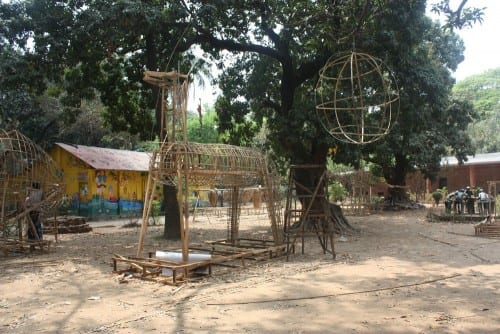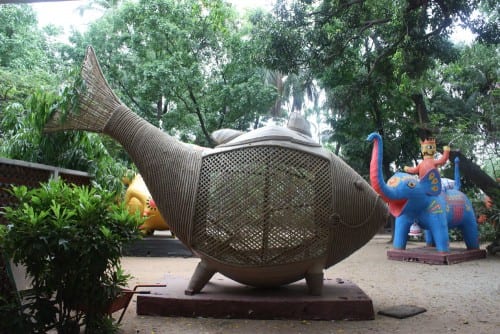Notes on Bangladesh – Olivia Bax
By ucwajgo, on 30 June 2015
One of the first things to strike me during my month at Dhaka University was the generosity of the people. Sam Llewellyn-Jones and I were assigned three students who were to accompany us at all times and help whenever necessary. All three took this responsibility very seriously. Nothing was too great a chore even if it meant embarking on an afternoon excursion out of Dhaka to find a particular roll of paper which we had casually mentioned that we might need.

14 April – Bengali New Year. Wearing traditional Bengali clothes. Left to right: Shochi, Olivia, Alok, Oni, Sam
Bengali New Year
Their enthusiastic commitment was particularly apparent when we arrived in early April just as preparations for Bengali New Year had got under way. Students were creating gigantic bamboo structures of folk sculptures (mostly large animals) as well as myriads of papier-mâché masks, paintings and clay ornaments. Every student in the Art School, across all disciplines including sculpture, painting, craft, graphic design, ceramics, oriental art and printmaking, was involved. This universal effort of making continued throughout our first two weeks until the ceremony on 14 April. The event itself was incredible. To my astonishment, all of the individually hand-painted owl and tiger masks were used; each bamboo sculpture that had been covered in paper was paraded down the street. There were people everywhere, celebrating and taking pictures. New Year celebrations at home are very tame in comparison. But what was so notably different is that this was a community effort. Everyone at the Art School contributed to the event. All these students, who attend Art School for up to 6 years, taking four years to pursue a BA course and two years for an MA, work on the making for the celebration every year. I tried to think of a time where art students in the UK get together to make things en masse but drew a blank. True, the end of year degree shows involve a collaboration of sorts in order to turn art schools into gallery spaces to showcase work. But the intention is different: the objective is to celebrate individual art practices. It is not a cultural event where students actively collaborate to mark a milestone.

Gigantic bamboo structures of traditional folk art being made at Dhaka University, Fine Art Campus, in preparation for Bengali New Year
The Joy of Materials
It was the making which fascinated me most in the Art School. Across disciplines it was clear that the students were taught skills in a formal way. In the sculpture department, all students could carve, cast, weld and draw. This is in stark contrast to the UK where students only learn what they need. Here it means that an art student can leave after six years of formal art education without knowing how to mix plaster. One day, when I was making some work outside the school in Dhaka, a student said, ‘I think that we are better with our hands but you are better with your minds.’ She continued, ‘Imagine what someone could be if they had both?’ I have thought a lot about her comment. When I was an undergraduate student, I wanted to learn metal work something which I managed to do. Later I discovered the joy of materials – there was something about discovery through making which appealed to me – and the uncertainty or surprise of it. Later still as assistant to Anthony Caro I learned the problems of ‘craft’ in sculpture. He said that making something ‘too well’ can kill the art. I wonder now where lies the balance between art and craft. Having witnessed the Dhaka approach, I think it would be valuable for art students here to acquire more skills. Perhaps UK students are unwittingly restrained because they are untrained in certain skills or inexperienced in certain materials. If they were more skilled, would they make better material judgements? Or is it this very state that makes students inventive and imaginative?
Impressions of Dhaka
Dhaka was a vibrant and a chaotic place. It was full of people, excitement and most of all, noise. All around, everywhere, everyday, there was bustle and the sense of things happening. Even the skyline has an air of anticipation with steel protruding upwards from unfinished buildings, waiting for another layer to be added. I had never experienced a place with so much potential nor so many sources of inspiration: bamboo sticks, multi-coloured markets, painted surfaces, construction sites. Of course, when things become familiar it is less easy to see them but I wondered why were Sam and I interested in taking pictures of the same things? Why was there something about the raw clay or the casting foundries that fascinated both of us? I wonder when it was that we were taught to see. I remember on my Foundation course being taken to the Barbican in London and a teacher exclaiming, ‘This is the finest building in London.’ I could not understand. Not long after I discovered that I could see it. Now I find myself telling people the same thing. Equally, a particularly inspiring teacher on my undergraduate course at Byam Shaw advised that ‘there is no point in drawing exactly what you are about to make’. That was another eureka moment: that art should have something unexplained, which is why it is a visual experience.
What is your concept?
I arrived at the Art School in Dhaka with no preconceived ideas for work. I tried to absorb the place and take inspiration from the surroundings. I made work with materials I found interesting, most notably jute (which proved surprisingly strong), bamboo, coloured pigment and handmade paper. It attracted a lot of attention when both Sam and I were making and I was not used to the persistent question of, ‘What is your concept?’ I often try to make sense of the whole after I have finished, working things out along the way. For me, art is not about delivering a ‘concept’ but about exploring the unknown. I tried to express these thoughts to the students who appeared to be responsive.

Presentation at the sculpture department ‘Notes on Dhaka’: Bamboo, jute, plaster, pigment, handmade paper, tape

Digital print available in ‘Impressions’ a limited edition catalogue by Olivia Bax and Sam Llewellyn Jones
Final thoughts
At the Slade, and particularly at Masters level, there is an acceptance that students have had to sacrifice a lot (normally financially) in order to be there. Everyone’s work is his/her number one priority and the ambition to become an artist is evident. Unlike Dhaka students who continue their MA straight after their BA, most students have returned to education after a few years out, working and making work in private studios. For Dhaka students, being there is also a formidable achievement. There are 6000 students who apply for just over 100 places (across all the disciplines) at the Art School. Dhaka University is the only place in the country offering subsidised fine art tuition. All other universities are private and therefore expensive. Many students have come from very underprivileged backgrounds. For them, the idea of a career in art is impossible. They are resigned to a ‘job’ when they leave the haven of the art school. Their experience as students bonds them, I would say, more than friendships created in UK schools. In Bangladesh, students treat peers as family. This results in a cohort without a competitive sensibility something which prevails so often in London art schools. Instead, like their preparations for New Year suggested, they enjoy a sense that they are all one, with the privilege of having six years together, learning skills and making work. They are as proud of their Art School as they are of their country. The experience has raised many questions for me. And I am sure the experience will continue to inspire me for months and years to come.
Olivia Bax, May 2015
 Close
Close







